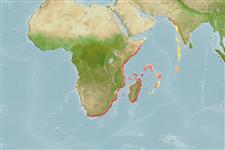Environment: milieu / climate zone / depth range / distribution range
Ecologia
marino; acqua dolce; salmastro demersale; catadromo (Ref. 51243). Tropical; 25°N - 35°S
Western Indian Ocean: east coast rivers of Africa from Kenya south to Cape Agulhas, also in Madagascar and other western Indian Ocean islands (Ref. 7248, 52193). Reported from New Caledonia (Ref. 11889).
Size / Peso / Age
Maturity: Lm ? range ? - ? cm
Max length : 150 cm TL maschio/sesso non determinato; (Ref. 3506); 120.0 cm SL (female); peso massimo pubblicato: 5.7 kg (Ref. 52193); peso massimo pubblicato: 5.7 kg; Età massima riportata: 20 anni (Ref. 48660)
Spine dorsali (totale): 0; Spine anali 0.
Migratory species, which breeds in the ocean (Ref. 52331). Inhabits both quiet and fast flowing water (Ref. 13337). Elvers ascend rivers mainly at night and overcome waterfalls and walls of dams with great determination. Adults usually sedentary. Females can attain 120 cm SL and are generally longer and heavier than males (Ref. 48660). Carnivorous, eats dead or living prey but especially fish and crabs. After feeding in fresh water for ten years or more, adults assume a silver breeding dress, the eyes become enlarged and they return to sea to breed. Considered to breed east of Madagascar, but thought to move south of that island on its way to the Mozambique coast and South African rivers (Ref. 13337). Flesh fatty but highly esteemed as smoked or jellied eel (Ref. 5214). Caught with various types of nets (Ref. 4967).
Life cycle and mating behavior
Maturità | Riproduzione | Deposizione | Uova | Fecundity | Larve
Castle, P.H.J., 1984. Anguillidae. p. 34-37. In J. Daget, J.-P. Gosse and D.F.E. Thys van den Audenaerde (eds.) Check-list of the freshwater fishes of Africa (CLOFFA). ORSTOM, Paris and MRAC, Tervuren. Vol. 1. (Ref. 3506)
IUCN Red List Status (Ref. 130435)
Threat to humans
Harmless
Human uses
Pesca: commerciale; Acquacoltura: commerciale; Pesce da pesca sportiva: si
Informazioni ulteriori
Nomi ComuniSinonimiMetabolismoPredatoriEcotossicologiaRiproduzioneMaturitàDeposizioneSpawning aggregationFecundityUovaEgg development
BibliografiaAcquacolturaProfilo di acquacolturaVarietàGeneticaElectrophoresesEreditarietàMalattieElaborazioneNutrientsMass conversion
Strumenti
Special reports
Download XML
Fonti Internet
Estimates based on models
Preferred temperature (Ref.
123201): 19.6 - 27.5, mean 26.4 °C (based on 98 cells).
Phylogenetic diversity index (Ref.
82804): PD
50 = 0.5000 [Uniqueness, from 0.5 = low to 2.0 = high].
Bayesian length-weight: a=0.00089 (0.00051 - 0.00156), b=3.20 (3.05 - 3.35), in cm total length, based on LWR estimates for this species & Genus-body shape (Ref.
93245).
Trophic level (Ref.
69278): 3.3 ±0.55 se; based on food items.
Generation time: 26.8 ( na - na) years. Estimated as median ln(3)/K based on 1
growth studies.
Resilienza (Ref.
120179): Molto basso, tempo minimo di raddoppiamento della popolazione più di 14 anni (K=0.04).
Fishing Vulnerability (Ref.
59153): Very high vulnerability (81 of 100).
